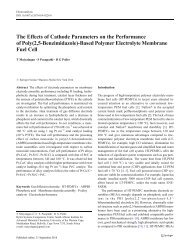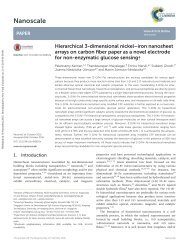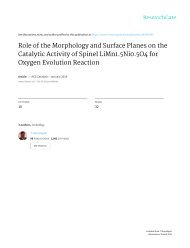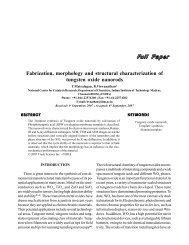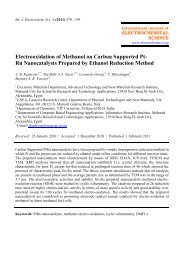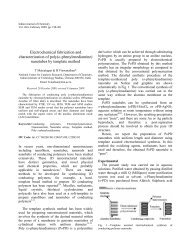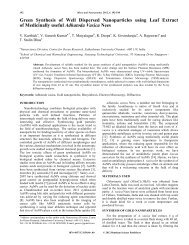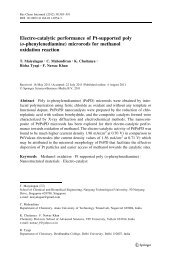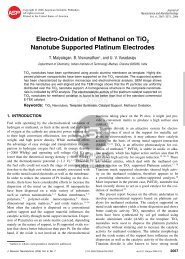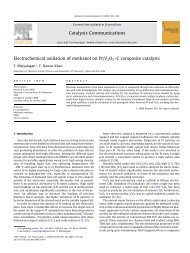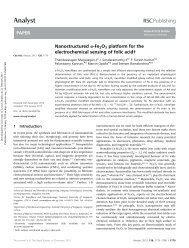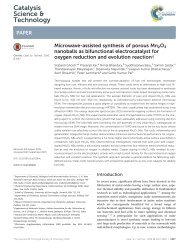Optical studies of nano-structured La-doped ZnO prepared by combustion method
Create successful ePaper yourself
Turn your PDF publications into a flip-book with our unique Google optimized e-Paper software.
Materials Science in Semiconductor Processing 15 (2012) 308–313<br />
Contents lists available at SciVerse ScienceDirect<br />
Materials Science in Semiconductor Processing<br />
journal homepage: www.elsevier.com/locate/mssp<br />
<strong>Optical</strong> <strong>studies</strong> <strong>of</strong> <strong>nano</strong>-<strong>structured</strong> <strong>La</strong>-<strong>doped</strong> <strong>ZnO</strong> <strong>prepared</strong> <strong>by</strong><br />
<strong>combustion</strong> <strong>method</strong><br />
L. Arun Jose a , J. Mary Linet a , V. Sivasubramanian b , Akhilesh K. Arora c , C. Justin Raj d ,<br />
T. Maiyalagan e , S. Jerome Das a,n<br />
a Department <strong>of</strong> Physics, Loyola College, Chennai 600034, India<br />
b Light Scattering Studies Section, IGCAR, Kalpakkam 603102, India<br />
c Condensed Matter Physics Division, IGCAR, Kalpakkam 603102, India<br />
d Pusan National University, Jangjeon, Geumjeong, Busan 609 735, South Korea<br />
e School <strong>of</strong> Chemical and Biomedical Engineering, Nanyang Technological University, Singapore 639 798, Singapore<br />
article info<br />
Article history:<br />
Received 4 August 2011<br />
Received in revised form<br />
13 March 2012<br />
Accepted 14 March 2012<br />
Available online 21 April 2012<br />
Keywords:<br />
Doping<br />
Semiconducting II–VI materials<br />
Nano-structures<br />
<strong>combustion</strong><br />
X-ray diffraction spectra<br />
Zinc compounds<br />
Rare earth compounds<br />
abstract<br />
Coral-shaped <strong>nano</strong>-<strong>structured</strong> zinc oxide (<strong>ZnO</strong>) was successfully synthesized and <strong>La</strong><strong>doped</strong><br />
via a facile <strong>combustion</strong> process using glycine as a fuel. The auto-ignition<br />
(at 185 1C) <strong>of</strong> viscous reactants zinc nitrate and glycine resulted in <strong>ZnO</strong> powders.<br />
Hexagonal wurtzite structure <strong>of</strong> pure and <strong>doped</strong> <strong>ZnO</strong> powder was confirmed <strong>by</strong> X-ray<br />
powder diffraction analysis. The transmission electron micrograph shows that the<br />
<strong>nano</strong>-<strong>structured</strong> <strong>ZnO</strong> is coral-shaped and possess maximal pore (10–50 nm pore size)<br />
density in it and the grain size is approximately about 15 nm. Addition <strong>of</strong> dopants<br />
subsequently alters the structural and optical properties which were confirmed <strong>by</strong><br />
UV–VIS <strong>studies</strong>.<br />
& 2012 Elsevier Ltd. All rights reserved.<br />
1. Introduction<br />
Nano-<strong>structured</strong> metal oxide semiconductors are gaining<br />
attention due to their wide band-gap and related<br />
properties [1]. Recent decades are witnessed with<br />
researchers paying much interest in synthesis and characterization<br />
<strong>of</strong> II–VI group semiconducting materials at<br />
<strong>nano</strong>- [2] and bulk [3] levels. Zinc oxide (<strong>ZnO</strong>) is a widely<br />
exploited, due to its excellent physical and chemical<br />
properties. Numerous researchers proposed the solution<br />
<strong>combustion</strong> <strong>method</strong> to synthesize simple and mixed<br />
metal oxides [4–9]. Normally <strong>ZnO</strong> is <strong>doped</strong> with different<br />
n Corresponding author. Tel.: þ91 44 2817 5662;<br />
fax: þ91 44 2817 5566.<br />
E-mail addresses: sjeromedas2004@yahoo.com,<br />
jerome@loyolacollege.edu (S. Jerome Das).<br />
types <strong>of</strong> metallic ions in order to enhance the optical and<br />
conducting properties [10–14]. The exceptional interest<br />
on <strong>ZnO</strong> may be seen in the recent literatures. The<br />
modified <strong>ZnO</strong> may be used as a base material for diluted<br />
magnetic semiconductors [15–18], gas sensors [19],<br />
photocatalysts [20], field-effect transistors [21,22], lightemitting<br />
materials [23–25], solar cells [26,27] and biological<br />
systems (drug delivery, bio-imaging, etc.) [28,29]. In<br />
the recent times, rare earth metal-<strong>doped</strong> <strong>ZnO</strong> (e.g., Tb, Er,<br />
Eu, Dy and Sm) has been broadly researched and concentrated<br />
on luminescence properties [24,30–33]. <strong>La</strong>nthanum<br />
(<strong>La</strong>)-<strong>doped</strong> <strong>ZnO</strong> <strong>nano</strong>-structures exhibit excellent<br />
photocatalytic activity and gas sensitivity [20,34–36].<br />
Nano-sized <strong>ZnO</strong> has been synthesized <strong>by</strong> the solution<br />
<strong>combustion</strong> <strong>method</strong> and there are no literature references<br />
for <strong>La</strong>-<strong>doped</strong> <strong>ZnO</strong> using this <strong>method</strong>. Current work is focused<br />
on investigating the result <strong>of</strong> <strong>La</strong> doping concentration on the<br />
1369-8001/$ - see front matter & 2012 Elsevier Ltd. All rights reserved.<br />
http://dx.doi.org/10.1016/j.mssp.2012.03.011
L. Arun Jose et al. / Materials Science in Semiconductor Processing 15 (2012) 308–313 309<br />
Glycine (NH 2 CH 2 COOH) Zinc Nitrate (Zn(NO 3 ) 2 •6H 2 O) <strong>La</strong>nthanum Nitrate (<strong>La</strong>(NO 3 ) 2 •6H 2 O)<br />
Mixed with (1-x): x molar ratio<br />
where x = 0.01, 0.02. 0.03 and 0.05 <strong>of</strong> (<strong>La</strong>(NO 3 ) 2 •6H 2 O)<br />
Directly mixed with desired (1:09) molar<br />
ti<br />
Heating / Development <strong>of</strong> precursor<br />
Ignition / Combustion / Burning<br />
Synthesized Material (powder)<br />
Fig. 1. Procedural flow chart for preparation <strong>of</strong> <strong>ZnO</strong> with/without <strong>La</strong>-dopant.<br />
Fig. 2. TEM Images: (a) bright field, (b) dark field, (c) detailed view, (d) diffraction pattern and (e) EDS pattern <strong>of</strong> pure <strong>ZnO</strong>.
310<br />
L. Arun Jose et al. / Materials Science in Semiconductor Processing 15 (2012) 308–313<br />
microstructure and optical properties <strong>of</strong> <strong>ZnO</strong> <strong>nano</strong>-structure<br />
<strong>prepared</strong> <strong>by</strong> the <strong>combustion</strong> <strong>method</strong>.<br />
2. Experimental details<br />
Distinct from usual thermal evaporation, <strong>ZnO</strong> <strong>nano</strong>structures<br />
were <strong>prepared</strong> <strong>by</strong> the <strong>combustion</strong> <strong>method</strong>, which<br />
allows efficient synthesis <strong>of</strong> <strong>nano</strong>-size materials. This process<br />
involves a self-sustained reaction in homogeneous<br />
solution <strong>of</strong> different oxidizers (e.g., metal nitrates) and fuels<br />
(e.g., urea, glycine, citric acid, hydrazides). Depending on the<br />
type <strong>of</strong> precursors, and the suitable conditions for chemical<br />
reaction to take place, zinc nitrate (Zn(NO 3 ) 2 6H 2 O) was<br />
chosen as an oxidizer and glycine (NH 2 CH 2 COOH) as a fuel,<br />
since its <strong>combustion</strong> heat ( 3.24 kcal/g) is more negative<br />
when compared with urea ( 2.98 kcal/g) or citric acid<br />
( 2.76 kcal/g) [36]. <strong>La</strong>nthanum nitrate (<strong>La</strong>(NO 3 ) 2 6H 2 O) is<br />
added to zinc nitrate with required molar ratio and glycine<br />
is also added along with it, in a molar ratio <strong>of</strong> 0.9:1 (zinc<br />
nitrateþlanthanum nitrate:glycine) and stirred well for 1 h<br />
in 100 ml double distilled water. The obtained solution is<br />
heated (185 1C) till <strong>combustion</strong> reaction occurs. Procedural<br />
flow chart diagram for the preparation <strong>of</strong> precursors<br />
and the formation <strong>of</strong> <strong>nano</strong>-structures is shown in Fig. 1.<br />
Crystallinity <strong>of</strong> pure <strong>ZnO</strong> and <strong>La</strong>-<strong>doped</strong> <strong>ZnO</strong> catalysts were<br />
analyzed <strong>by</strong> Philips CM 20 Transmission Electron Microscope<br />
which was operated between 20 and 200 kV. Composition<br />
<strong>of</strong> the samples were analyzed <strong>by</strong> energy dispersive<br />
X-ray spectroscopy (EDS) attached to the TEM instrument.<br />
X-ray diffraction patterns <strong>of</strong> the synthesized samples were<br />
Fig. 3. TEM images: (a) bright field, (b) dark field, (c) detailed view, (d) diffraction pattern and (e) EDS pattern <strong>of</strong> 5 mol % <strong>La</strong>-<strong>doped</strong> <strong>ZnO</strong>.
L. Arun Jose et al. / Materials Science in Semiconductor Processing 15 (2012) 308–313 311<br />
recorded using PAN analytical X-ray diffractometer with Cu<br />
Ka (1.5405 Å) radiation in the scan range 2y between 301<br />
and 701 with a scan speed <strong>of</strong> 21/min. UV–VIS spectra <strong>of</strong> pure<br />
<strong>ZnO</strong> and <strong>La</strong>-<strong>doped</strong> <strong>ZnO</strong> catalysts were recorded using Varian<br />
CARY 5E UV–VIS–NIR Spectrophotometer. The absorbance<br />
spectra were then recorded in the range 200–700 nm.<br />
Photoluminescence <strong>of</strong> pure <strong>ZnO</strong> and <strong>La</strong>-<strong>doped</strong> <strong>ZnO</strong> were<br />
measured <strong>by</strong> Jobin Yvon Fluorolog spectr<strong>of</strong>luorometer and<br />
the results are discussed in detail.<br />
3. Results and discussion<br />
TEM analysis shows that the <strong>nano</strong>-structures which<br />
had been synthesized using <strong>combustion</strong> processing are<br />
coral-shaped and porous as shown in Fig. 2. This shape<br />
may be attributed to the thermal fluctuations while<br />
synthesizing the samples. Grain size is found to be<br />
10–20 nm both in the case <strong>of</strong> pure and <strong>doped</strong> <strong>ZnO</strong>.<br />
Porous nature <strong>of</strong> the <strong>nano</strong>-structures significantly increases<br />
as the <strong>La</strong>-dopant concentration increases as shown in Fig. 3.<br />
Each individual <strong>nano</strong>-structure is about 450–1000 nm<br />
formed <strong>by</strong> tiny spherical <strong>ZnO</strong> <strong>nano</strong>particles. We can also<br />
notice that the pores are 10–50 nm in diameter which<br />
considerably increase the surface to volume ratio. Selected<br />
area diffraction patterns match very well with wurtzite<br />
<strong>ZnO</strong> in both pure and <strong>doped</strong> <strong>ZnO</strong>. EDS analysis shows that<br />
some <strong>La</strong> 3þ ions have been incorporated into the <strong>ZnO</strong> lattice<br />
<strong>by</strong> substituting zinc ions as shown in Fig. 3(e) and in<br />
Table 1. When <strong>La</strong> is present the composition <strong>of</strong> oxygen<br />
seems to be nearly constant. This may be due to the<br />
addition <strong>of</strong> oxygen atoms in the <strong>La</strong>-<strong>doped</strong> <strong>ZnO</strong> which was<br />
accommodated <strong>by</strong> the additional vacancy in the <strong>La</strong> 3þ ion.<br />
Copper peak in the EDS measurement originates from the<br />
TEM supporting carbon coated copper grid.<br />
XRD pr<strong>of</strong>iles <strong>of</strong> synthesized pure and <strong>doped</strong> materials<br />
in appropriate ratio are shown in Fig. 4. The diffraction<br />
peaks and their relative intensities match with the JCPDS<br />
card no. 36-1451. Hence the observed patterns can be<br />
clearly endorsed to the presence <strong>of</strong> hexagonal wurzite<br />
structure. XRD peak <strong>of</strong> lanthanum oxide was not observed<br />
Table 1<br />
Composition <strong>of</strong> elements in <strong>La</strong>-<strong>doped</strong> <strong>ZnO</strong> samples.<br />
<strong>La</strong> concentration (mol%) Element weight (%) Atomic (%)<br />
0 O 13.30 38.50<br />
Zn 86.70 61.50<br />
1 O 20.30 51.73<br />
<strong>La</strong> 04.34 01.27<br />
Zn 75.36 47.00<br />
2 O 19.60 51.32<br />
<strong>La</strong> 08.38 02.53<br />
Zn 72.02 46.15<br />
3 O 18.94 50.92<br />
<strong>La</strong> 12.15 03.76<br />
Zn 68.91 45.32<br />
5 O 18.30 50.80<br />
<strong>La</strong> 17.20 05.50<br />
Zn 64.50 43.70<br />
Fig. 4. Powder XRD spectra <strong>of</strong> samples pure–<strong>doped</strong> <strong>prepared</strong> at different<br />
mol percent <strong>of</strong> <strong>La</strong>.<br />
even for the <strong>La</strong>-<strong>doped</strong> sample with a high <strong>La</strong> concentration,<br />
suggesting that lanthanum oxide is uniformly dispersed<br />
in the <strong>ZnO</strong> and no second phase such as <strong>La</strong> 2 O 3 and<br />
<strong>La</strong>(OH) 3 appears. It is evident that the introduction <strong>of</strong> <strong>La</strong><br />
ions does not alter the structure <strong>of</strong> <strong>ZnO</strong> and dopant<br />
disperses homogeneously in the <strong>ZnO</strong> matrix as previously<br />
reported [37]. Using the Scherrer equations the crystallite<br />
sizes were estimated to be around 450 nm from the fullwidth<br />
at half-maximum (FWHM) <strong>of</strong> diffraction peaks. The<br />
diffraction pattern <strong>of</strong> <strong>ZnO</strong> is observed between the 2y<br />
values <strong>of</strong> 301 and 701. The peak intensities <strong>of</strong> <strong>doped</strong> <strong>ZnO</strong><br />
increases with dopant concentration. Therefore, the crystalline<br />
nature <strong>of</strong> <strong>ZnO</strong> <strong>nano</strong>structure increases with <strong>La</strong>dopant<br />
in the same manner as previously reported in the<br />
case <strong>of</strong> Fe <strong>doped</strong> <strong>ZnO</strong> [38]. Doping <strong>of</strong> <strong>La</strong> ions restrains the<br />
growth <strong>of</strong> <strong>ZnO</strong> grains and dopant with smaller ionic<br />
radius has a constructive effect on diffusivity which<br />
promotes orientation growth and good crystal [39]. The<br />
lattice parameters and the unit cell volume were determined<br />
using s<strong>of</strong>tware program UnitCell <strong>method</strong> <strong>of</strong> TJB<br />
Holland & SAT Redfern [40]. The determined unit cell<br />
parameters, volume and c/a were plotted as a function <strong>of</strong><br />
<strong>La</strong> concentrations and are shown in Figs. 5 and 6 respectively.<br />
The lattice constant gradually increases with<br />
increase in concentration <strong>of</strong> <strong>La</strong> 3 þ ions. Consequently, cell<br />
volume and c/a ratio changed, agreeing with the fact that<br />
ionic radii <strong>of</strong> <strong>La</strong> 3 þ is higher than the Zn 2 þ ion (0.106 nm<br />
for <strong>La</strong> and 0.074 nm for Zn) [41,42] but there is a small<br />
variation in c-axis compared with the results <strong>of</strong> Chen et al.<br />
[37]. This distortion in the lattice parameters confirms the<br />
incorporation <strong>of</strong> <strong>La</strong> 3 þ ions up to 5 mol% in <strong>ZnO</strong> wurzite<br />
structure.<br />
UV–VIS spectrum shows that the absorbance is high<br />
below 380 nm for pure <strong>ZnO</strong> and as the <strong>La</strong>-dopant concentration<br />
increases the absorbance <strong>of</strong> <strong>ZnO</strong> decreases<br />
considerably below this region as shown in Fig. 7. The<br />
corresponding band gap values <strong>of</strong> pure and <strong>doped</strong> <strong>ZnO</strong> are
312<br />
L. Arun Jose et al. / Materials Science in Semiconductor Processing 15 (2012) 308–313<br />
Fig. 5. Unit cell parameters a and c were plotted as a function <strong>of</strong> <strong>La</strong><br />
concentration.<br />
Fig. 8. Calculated band gap <strong>of</strong> pure and <strong>La</strong>-<strong>doped</strong> <strong>ZnO</strong>.<br />
Fig. 6. Unit cell volume and c/a were plotted as a function <strong>of</strong> <strong>La</strong><br />
concentration.<br />
Fig. 9. Room temperature PL emission spectra <strong>of</strong> <strong>ZnO</strong> with/without<br />
<strong>La</strong>-dopant.<br />
Fig. 7. UV–VIS spectra <strong>ZnO</strong> with/without dopant.<br />
presented in Fig. 8. It can be clearly seen that the band gap<br />
<strong>of</strong> <strong>La</strong>-<strong>doped</strong> <strong>ZnO</strong> also increases gradually with increase in<br />
<strong>La</strong> concentration. After 380 nm, absorbance <strong>of</strong> pure <strong>ZnO</strong> is<br />
less compared with <strong>La</strong>-<strong>doped</strong> <strong>ZnO</strong> and absorbance<br />
increases with increase in dopant concentration.<br />
Photoluminescence (PL) spectra <strong>of</strong> <strong>La</strong>-<strong>doped</strong> <strong>ZnO</strong><br />
<strong>nano</strong>-structures were measured with an excitation wavelength<br />
<strong>of</strong> 285 nm and is shown in Fig. 9. The intensity <strong>of</strong><br />
PL emission is found to increase with increase in <strong>La</strong>dopant,<br />
but the intensity <strong>of</strong> <strong>doped</strong> <strong>ZnO</strong> decreases in<br />
comparison with pure <strong>ZnO</strong> between 3.2 and 3.3 eV. The<br />
PL spectrum shows the <strong>La</strong> characteristic emission band at<br />
2.9 eV and near UV emission between 3.27 and 3.30 eV.<br />
There is a shift in the emission spectra for pure and <strong>doped</strong><br />
<strong>ZnO</strong>. This may be attributed due to the strain created in<br />
the crystal lattice to accommodate larger <strong>La</strong> atoms.<br />
Spectra in the range <strong>of</strong> 340–460 nm (2.7–3.6 eV) shows<br />
that a violet peak at about 420 nm (2.95 eV) and the<br />
intensity <strong>of</strong> emission are found to be strongly reliant on<br />
the <strong>La</strong> concentration. Traps on the grain surface per unit<br />
volume increases with the increase <strong>of</strong> specific surface<br />
area. Cordaro et al. [43] assumed that interface traps lie in
L. Arun Jose et al. / Materials Science in Semiconductor Processing 15 (2012) 308–313 313<br />
the depletion regions and locate at the <strong>ZnO</strong>–<strong>ZnO</strong> grain<br />
boundaries when a polycrystalline varistor forms, and the<br />
level <strong>of</strong> interface trap was found to be about 0.33 eV<br />
below the conduction band edge. So violet emission is<br />
possibly attributed to the recombination centers linked<br />
with interface traps existing at the grain boundaries, and<br />
radiative transition occurs between the level <strong>of</strong> interface<br />
traps and the valence band.<br />
4. Conclusions<br />
<strong>La</strong>-<strong>doped</strong> <strong>ZnO</strong> was <strong>prepared</strong> <strong>by</strong> <strong>combustion</strong> processing;<br />
doping levels included un<strong>doped</strong>, 1, 2, 3 and 5 molar<br />
percentage. Significant transformation was observed upon<br />
different doping concentrations. Transmission electron<br />
micrograph shows an enhancement <strong>of</strong> pore density for<br />
<strong>doped</strong> <strong>ZnO</strong>. <strong>La</strong>ttice parameters and unit cell volume were<br />
determined from the XRD data and it confirms the entry<br />
<strong>of</strong> <strong>La</strong>-dopant inside <strong>ZnO</strong> crystal lattice <strong>by</strong> the increase in<br />
lattice constants. It is evident that the absorbance near UV<br />
region decreases with increase in dopant concentration.<br />
The bandgap is found to increase with addition <strong>of</strong> <strong>La</strong>. The<br />
<strong>La</strong>-<strong>doped</strong> <strong>ZnO</strong> <strong>nano</strong>-structures <strong>prepared</strong> at low temperatures<br />
are more suitable for applications such as chemical<br />
and biological sensors, optoelectronic devices, and<br />
solar cells.<br />
Acknowledgments<br />
The authors gratefully acknowledge BRNS (Board <strong>of</strong><br />
Research in Nuclear Sciences—Government <strong>of</strong> India, Project<br />
no. 2008/37/12/BRNS/1513) for providing financial<br />
assistance. They are also thankful to authorities <strong>of</strong> Indian<br />
Institute <strong>of</strong> Technology, Chennai 36, for providing TEM,<br />
UV–VIS, PL and powder XRD facility.<br />
References<br />
[1] J.B. Varley, A. Janotti, C. Franchini, C.G. Van de Walle, Physical<br />
Review B 85 (2012) 081109. R.<br />
[2] P.K. Sharma, R.K. Dutta, M. Kumar, P.K. Singh, A.C. Pandey, Journal<br />
<strong>of</strong> Luminescence 129 (2009) 605–610.<br />
[3] J. Kennedy, D.A. Carder, A. Markwitz, R.J. Reeves, Journal <strong>of</strong> Applied<br />
Physics 107 (2010) 103518.<br />
[4] H.-C. Shin, K.-R. Lee, S. Park, C.-H. Jung, S.-J. Kim, Japanese Journal <strong>of</strong><br />
Applied Physics 35 (1996) L996–L998.<br />
[5] F. Li, K. Hu, J. Li, D. Zhang, G. Chen, Journal <strong>of</strong> Nuclear Materials 300<br />
(2002) 82–88.<br />
[6] L.E. Shea, J. McKittrick, O.A. Lopez, E. Sluzky, Journal <strong>of</strong> the<br />
American Ceramic Society 79 (1996) 3257–3265.<br />
[7] L. Chick, L. Pederson, G. Maupin, J. Bates, L. Thomas, G. Exarhos,<br />
Materials Letters 10 (1990) 6–12.<br />
[8] T. Mimani, K.C. Patil, Materials Physics and Mechanics 4 (2001)<br />
134–137.<br />
[9] R.D. Purohit, B.P. Sharma, K.T. Pillai, A.K. Tyagi, Materials Research<br />
Bulletin 36 (2001) 2711–2721.<br />
[10] B.D. Ahn, S.H. Oh, C.H. Lee, G.H. Kim, H.J. Kim, S.Y. Lee, Journal <strong>of</strong><br />
Crystal Growth 309 (2007) 128–133.<br />
[11] H. Huang, Y. Ou, S. Xu, G. Fang, M. Li, X. Zhao, Applied Surface<br />
Science 254 (2008) 2013–2016.<br />
[12] V. Zhitomirsky, E. Cetinorgu, R. Boxman, S. Goldsmith, Thin Solid<br />
Films 516 (2008) 5079–5086.<br />
[13] T. Moriga, Y. Hayashi, K. Kondo, Y. Nishimura, K.-i. Murai,<br />
I. Nakabayashi, H. Fukumoto, K. Tominaga, Journal <strong>of</strong> Vacuum<br />
Science and Technology A 22 (2004) 1705.<br />
[14] S. Saha, V. Gupta, AIP Advances 1 (2011) 042112.<br />
[15] T.S. Herng, S.P. <strong>La</strong>u, S.F. Yu, H.Y. Yang, K.S. Teng, J.S. Chen, Journal <strong>of</strong><br />
Physics: Condensed Matter 19 (2007) 356214.<br />
[16] N.H. Hong, J. Sakai, V. Brizé, Journal <strong>of</strong> Physics: Condensed Matter<br />
19 (2007) 036219.<br />
[17] J. Zhang, X.Z. Li, J. Shi, Y.F. Lu, D.J. Sellmyer, Journal <strong>of</strong> Physics:<br />
Condensed Matter 19 (2007) 036210.<br />
[18] B. Li, X. Xiu, R. Zhang, Z. Tao, L. Chen, Z. Xie, Y. Zheng, Materials<br />
Science in Semiconductor Processing 9 (2006) 141–145.<br />
[19] T. Gao, T.H. Wang, Applied Physics A 80 (2004) 1451–1454.<br />
[20] S. Anandan, A. Vinu, T. Mori, N. Gokulakrishnan, P. Srinivasu, V.<br />
Murugesan, K. Ariga, Catalysis Communications 8 (2007)<br />
1377–1382.<br />
[21] Z.-X. Xu, V.A.L. Roy, P. Stallinga, M. Muccini, S. T<strong>of</strong>fanin, H.-F. Xiang,<br />
C.-M. Che, Applied Physics Letters 90 (2007) 223509.<br />
[22] C.-L. Hsu, T.-Y. Tsai, Journal <strong>of</strong> the Electrochemical Society 158<br />
(2011) K20–K23.<br />
[23] Y.R. Ryu, J.A. Lubguban, T.S. Lee, H.W. White, T.S. Jeong, C.J. Youn,<br />
B.J. Kim, Applied Physics Letters 90 (2007) 131115.<br />
[24] X.M. Teng, H.T. Fan, S.S. Pan, C. Ye, G.H. Li, Journal <strong>of</strong> Applied<br />
Physics 100 (2006) 053507.<br />
[25] S. Chirakkara, S.B. Krupanidhi, Physica Status Solidi RRL 6 (2012)<br />
34–36.<br />
[26] X. Chen, B. Xu, J. Xue, Y. Zhao, C. Wei, J. Sun, Y. Wang, X. Zhang,<br />
X. Geng, Thin Solid Films 515 (2007) 3753–3759.<br />
[27] P. Ruankham, T. Sagawa, H. Sakaguchi, S. Yoshikawa, Journal <strong>of</strong><br />
Materials Chemistry 21 (2011) 9710–9715.<br />
[28] S. Mendoza-Galván, C. Trejo-Cruz, J. Lee, D. Bhattacharyya,<br />
J. Metson, P.J. Evans, U. Pal, Journal <strong>of</strong> Applied Physics 99 (2006)<br />
014306.<br />
[29] I. Honma, S. Hirakawa, K. Yamada, J.M. Bae, Solid State Ionics 118<br />
(1999) 29–36.<br />
[30] M. Peres, A. Cruz, S. Pereira, M.R. Correia, M.J. Soares, A. Neves,<br />
M.C. Carmo, T. Monteiro, A.S. Pereira, M.A. Martins, T. Trindade,<br />
E. Alves, S.S. Nobre, R.A.Sá Ferreira, Applied Physics A 88 (2007)<br />
129–133.<br />
[31] S. Bachir, K. Azuma, J. Kossanyi, P. Valat, J.C. Ronfard-Haret, Journal<br />
<strong>of</strong> Luminescence 75 (1997) 35–49.<br />
[32] X.T. Zhang, Y.C. Liu, J.G. Ma, Y.M. Lu, D.Z. Shen, W. Xu, G.Z. Zhong,<br />
X.W. Fan, Thin Solid Films 413 (2002) 257–261.<br />
[33] G. Wu, Y. Zhuang, Z. Lin, X. Yuan, T. Xie, L. Zhang, Physica E<br />
31 (2006) 5–8.<br />
[34] S. Anandan, A. Vinu, K.L.P. Sheeja Lovely, N. Gokulakrishnan,<br />
P. Srinivasu, T. Mori, V. Murugesan, V. Sivamurugan, K. Ariga,<br />
Journal <strong>of</strong> Molecular Catalysis A: Chemical 266 (2007) 149–157.<br />
[35] C. Ge, C. Xie, M. Hu, Y. Gui, Z. Bai, D. Zeng, Materials Science and<br />
Engineering: B 141 (2007) 43–48.<br />
[36] C.-C. Hwang, T.-Y. Wu, Journal <strong>of</strong> Materials Science 39 (2004)<br />
6111–6115.<br />
[37] J.T. Chen, J. Wang, F. Zhang, G.A. Zhang, Z.G. Wu, P.X. Yan, Journal <strong>of</strong><br />
Crystal Growth 310 (2008) 2627–2632.<br />
[38] G.-Y. Ahn, S.-I. Park, S.-J. Kim, C.-S. Kim, Journal <strong>of</strong> Magnetism and<br />
Magnetic Materials 304 (2006) e498–e500.<br />
[39] S. Fujihara, C. Sasaki, T. Kimura, Journal <strong>of</strong> the European Ceramic<br />
Society 21 (2001) 2109–2112.<br />
[40] T.J.B. Holland, S.A.T. Redfern, Journal <strong>of</strong> Applied Crystallography 30<br />
(1997) 84.<br />
[41] S.H. Jeong, B.N. Park, S.B. Lee, J.H. Boo, Surface and Coatings<br />
Technology 193 (2005) 340–344.<br />
[42] Q. Yu, W. Fu, C. Yu, H. Yang, R. Wei, Y. Sui, S. Liu, Z. Liu, M. Li,<br />
G. Wang, C. Shao, Y. Liu, G. Zou, Journal <strong>of</strong> Physics D: Applied<br />
Physics 40 (2007) 5592.<br />
[43] J.F. Cordaro, Y. Shim, J.E. May, Journal <strong>of</strong> Applied Physics 60 (1986)<br />
4186.




